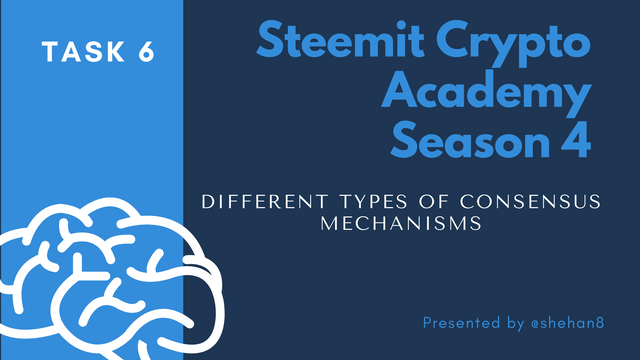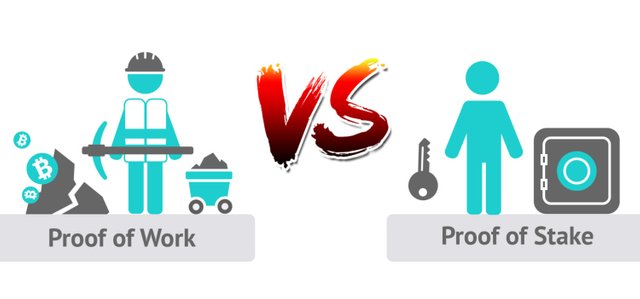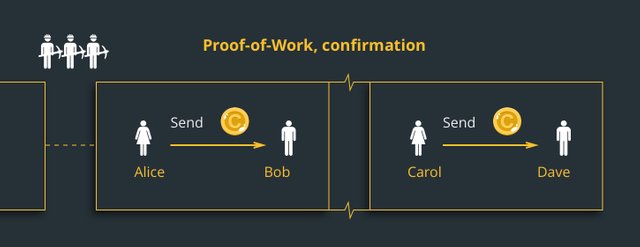[Different types of Consensus Mechanisms] - Steemit Crypto Academy Season 4 - Homework Post for TASK 6

Cover Image - https://www.canva.com/
QUESTION 1 :-
What is the difference between PoW & PoS? Advantages & Disadvantages? Which one is better in scaling Capacity? Examples?

This is the Source of above image.
Proof of Work "Pow"

This is the Source of above image.
Proof of Work "PoW", is a mechanism in which it requires a lot of computer force (equipment or computers of high capacity), to solve large and complex mathematical algorithms to reach consensus and be able to validate a transaction, this transaction will be registered in the public ledger of the blockchain in the form of a hash within a block and will be irreversible and can not be edited.
Today there are teams capable of performing mining operations through the PoW consensus mechanism, which according to their computing capacity can create blocks and earn rewards, the more the capacity, the mining time is reduced and the more its profitability will be, but the higher the cost of the equipment.
Nowadays there are many restrictions worldwide for the use of Proof of Work mining, the most predominant mining is that of bitcoin since the block production is only 10 minutes, The equipment is small for its simple transfer and provides great computer features, but they have a disadvantage which is that they need a lot of electrical energy for their operation, for this reason, there are many of the countries that have prohibited or regulated the use of this type of machinery, in my country Venezuela, the use of PoW mining is regulated, and only the government can give a temporary permit in exchange for a percentage produced, there are many people who carry out this type of mining clandestinely but they have to be surprised by the authorities and lose all the equipment and their freedom. Currently, the predominant mining is that of bitcoin with Pow, since it produces a lot of profitability.
The Proof of Stake "PoS"

This is the Source of above image.
The proof of stake "PoS" are validators in charge of validating transactions through nodes, these validators are chosen for having at their disposal large amounts of tokens under protection in a blockchain platform, they are also chosen by votes by the users of the ecosystem, if any transaction validator is not being their job as it should be, it can be changed by another validator, because their participation in the blockchain platform is extremely important since the platform depends on them.
Proof of stake does not require computing power to validate transactions, for this reason, it makes it more profitable than Proof of Work, but only a certain number of users qualify to delegate, other than proof of work that anyone can perform using a device with trained computing power.
The proof of stake is totally centralized and many of the current platforms are in need of adapting to this system, since the proof of work is extremely expensive energetically speaking, one of them is dash and soon Ethereum in its update 2.0.
A key point is that through proof of stake many of the platform's tokens are temporarily blocked, this helps their value in the market considerably.
Differences between PoW and PoS
The proof of work or PoW, is totally decentralized, which means that any user can take a computer with certain computer characteristics and start mining. In contrast to the PoS proof of stake, in which only certain users with the majority and stuck shares are privileged to be block validators which makes it a centralized system.
In the proof of work it is necessary of highly expensive and selective equipment to carry out a mining operation, in addition to the electricity consumption which its profitability is reduced, on the contrary to the proof of participation that only needs an internet network for the interconnection of nodes, this makes the PoS more profitable but somewhat selective.
PoW is limited in many parts of the world, otherwise, PoS is being accepted in all its diversity.
The time for the creation of blocks is also affected for the proof of work since currently, several projects have a very high block creation time as in the case of bitcoin that has a time of 10 minutes for the creation of blocks, otherwise what happens with the proof of stake that creates blocks in a matter of seconds.
The security through the proof-of-work protocol is extremely higher than the proof-of-stake protocol since it is centralized and tends to suffer attacks from cybercriminals.
| Advantages of PoW | Disadvantages of PoW |
|---|---|
| If you have the budget to acquire the computing power, it is profitable. | You need extremely expensive computing power. |
| If you have the budget to acquire the computing power, it is profitable. | Energetically it is extremely expensive. |
| Being decentralized, it is extremely safe. | There are prohibitions for its use. |
| When a block is created, the system rewards the opportunity to create the next one to the miner. | The time for block creation is extremely slow compared to other protocols. |
| Anyone can be part of the ecosystem. | Attack Percentage 51% |
| Advantages of PoS | Disadvantages of PoS |
|---|---|
| It is cost-effective as it only requires the use of an internet network. | Tends to be centralized |
| The validation speed is extremely short. | The minting of tokens depends on their majority investors. |
| Regulates the value of the token since the majority of investors seek to be validators and for this reason, they have their tokens retained. | Only those who own large amounts of stopped tokens can opt to be a validator in the protocol. |
| It is not prohibited since many platforms for their profitability are switching to this type of protocol. | You may be attacked by cybercriminals. |
I believe that the proof-of-stake (PoS) mechanism is better for scaling capacity, since it replaces the need for great mathematical computing power on the part of the participants (miners), eliminating the high costs of high energy consumption. This protocol takes as a basis the number of cryptocurrencies that a user has and in some cases, it also takes into account how long he has had those coins. That is, the more coins a person has, the greater their chances of being selected as a validator.
With this protocol by not having to perform computationally intensive work that consumes a large amount of time, it is possible to increase the speed by verifying a large number of transactions per second.
Thinking about speed and high scalability there are many cryptocurrencies that have applied the PoS protocol, some of them are: Cardano (ADA), Cosmos (Atom), Ark (ARK), Tron (TRX), Dash (DASH), Lisk (LSK), Tezos (XTZ), Algorand (ALGO) among others.
It is important to note that Cardano (ADA) is in third place in the list of cryptocurrencies with the largest market capitalization according to https://coinmarketcap.com/.
This is all about my homework post and I thank you to professor @sapwood for such a valuable topic that was really very educational.


#club5050 😀